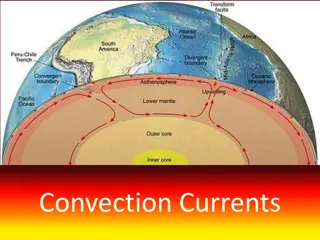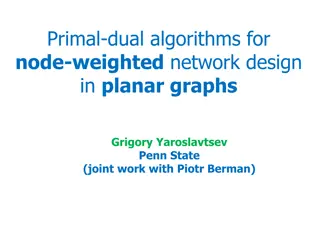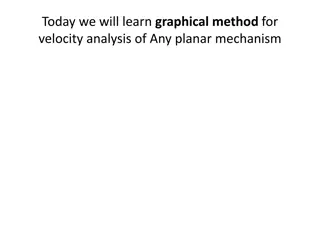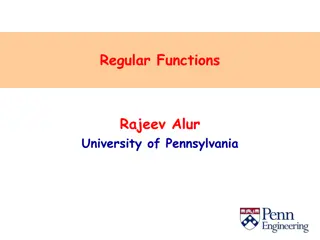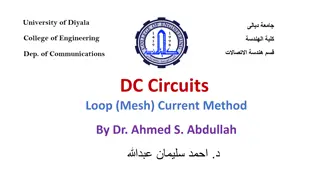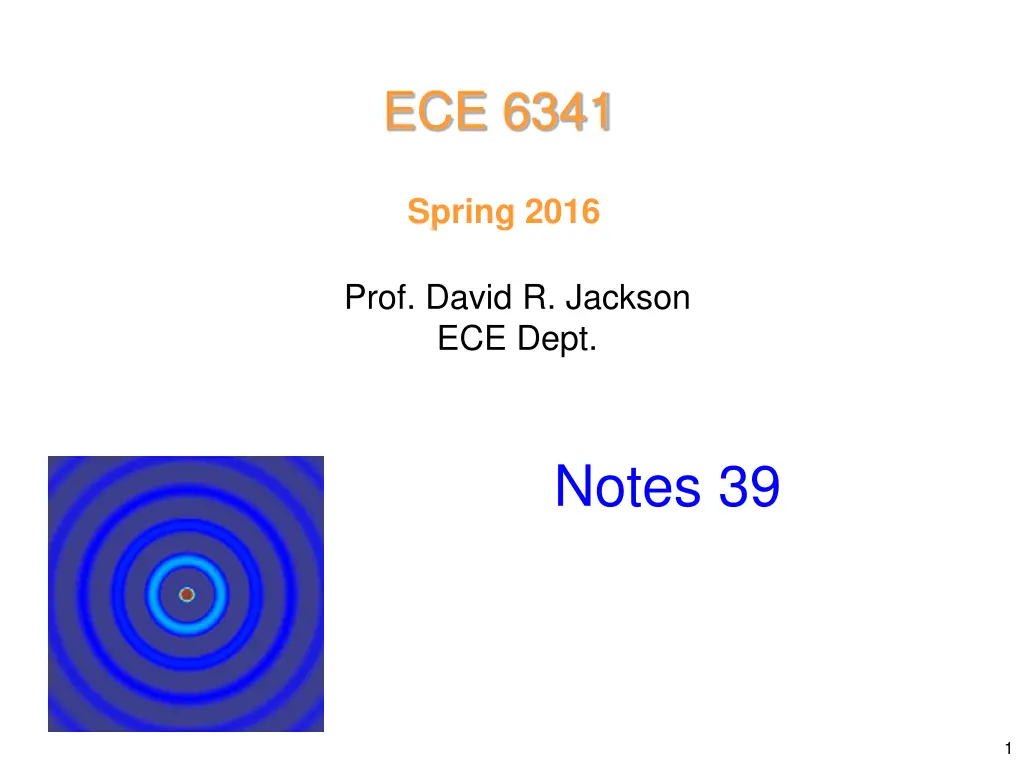
Electromagnetic Field Transformations and Modeling Equations Analysis
Explore the detailed analysis of electromagnetic field transformations and modeling equations, including concepts such as finite sources, TEN model, and example scenarios. Understand the relationships between electric fields, surface currents, and wave propagation in different mediums.
Download Presentation

Please find below an Image/Link to download the presentation.
The content on the website is provided AS IS for your information and personal use only. It may not be sold, licensed, or shared on other websites without obtaining consent from the author. If you encounter any issues during the download, it is possible that the publisher has removed the file from their server.
You are allowed to download the files provided on this website for personal or commercial use, subject to the condition that they are used lawfully. All files are the property of their respective owners.
The content on the website is provided AS IS for your information and personal use only. It may not be sold, licensed, or shared on other websites without obtaining consent from the author.
E N D
Presentation Transcript
ECE 6341 Spring 2016 Prof. David R. Jackson ECE Dept. Notes 39 1
Finite Source ( ) , J x y s ( ) ( ) + j k x k y p s p s = , J x y J e x y For a phased current sheet: 0 The tangential electric field that is produced is: ( )( z ) ( ) ( ) + j k x k y p s = TM , , x y z E uV J u e x y t 0 i )( ) ( ( ) ( ) z + j k x k y p s + + TE v v e V J x y 0 i 1 ( ) p s = , J J k k dk dk Recall that ( ) 0 s x y x y 2 2 2
Finite Source (cont.) Hence + + 1 ( ) ( ) z ( ) z = TM TE vV v , , x y z E uV J u J ( ) t i s i s 2 2 ( ) + j k x k y e dk dk x y x y ( ) ( ) = = u u k k v v k k , , , Note: x y x y y yk ( ) ( ) = , k k k , k k t x y x y u v x xk Wavenumber plane Spatial coordinates 3
TEN Model for Transform of Fields We can also write + + 1 ( ) ( ) ( ) + j k x k y = , , x y z , , E E k k z e dk dk x y ( ) t t x y x y 2 2 Comparing with the previous result, we have ( , , t x y E k k z uV = ) ( ) z ( ) z TM TE vV v J u J i s i s Similarly, ( ) ( ) z ( ) z = + TE TM v v I , , H k k z u I J J u t x y i s i s This motivates the following identifications: 4
TEN Model (cont.) Modeling equations for horizontal electric surface current: ( ) ( ) ( ) z = TM , , V z E k k z u t x y ( ) = TE v , , V E k k z t x y ( ( ) ) ( ) ( ) z = TE , , I z H k k z u t x y = TM v , , I H k k z t x y ( ( ) ) = TM s , I J k k u s x y = + TE s v , I J k k s x y 5
TEN Model (cont.) TM : z TM I + TM V = = = TM V E u t TM v I H t TM sI TM I J u s s 6
TEN Model (cont.) TE : z TE I + TE V = = = TE V E v t TE I H u t TE sI TE s v I J s 7
Example ( ) = x J , J x y s sx ( , , ) E x y z Find x ( ) ) ( ) ( ( ) = + x v E v , , E k k z u E u x x y t t ) ( ( ) ( z ) ( ) z = x u V + x v TM TE V 8
Example (cont.) y k k x u = = ( ) x cos = , k k k t x y t k k u y x v = = sin v t x Hence k k k k ( ) ( ) z ( ) z y = + TM TE x , , E k k z V V x x y t t k k k k ( ) z ( ) z y = + TM TE v x V J u V J i s i s t t k k k k ( ) ( ) ( ) y = = = = = = u v v x cos sin J J x u J J J J x J J s sx sx sx s sx sx sx t t 9
Example (cont.) Hence k k k k k k k k ( ) ( ) z ( ) z y y = + TM TE x x , , E k k z V J V J x x y i sx i sx t t t t 1 k ( ) z ( ) z = + 2 x 2 y TM TE J k V k V sx i i 2 t or 1 1 k ( ) z ( ) z = + 2 x 2 y TM TE ( , , ) E x y z J k V k V x sx i i 2 2 t (2 ) ( ) + j k x k y e dk dk x y x y 10
Dyadic Greens Function G G G G G G G G G xx xy xz ( ) x y ; , = , G x y z z yx yy yz zx zy zz where ( ) ( ) = , , G E x y z x y z , , due to the unit-amplitude electric dipole at ( ) ( , , J x y z j x = ij i ) ( ) ( ) x y y z z From superposition: Note: We have translational invariance due to the infinite substrate. ( ) ( ) ( ) x y ; , x y z dx dy = , ; , , , ; E x y z z G x y z z J s E E E J J J x sx We assume here that the currents are located on a planar surface z . = = E J where y s sy z sz 11
Dyadic Greens Function (cont.) ( ) ( ) ( ) x y ; , x y z dx dy = , ; , , , ; E x y z z G x y z z J s This is recognized as a 2D convolution: = G J E s Taking the 2D Fourier transform of both sides, = G J E s ( ) G k k z z = , ; , G where x y 12
Dyadic Greens Function (cont.) ( ) G k k z z , ; , = G J E is called the spectral-domain dyadic Green s function. x y s It is the Fourier transform of the spatial-domain dyadic Green s function. Assuming we wish the x component of the electric field due to an x-directed current Jsx (x , y ), we have = E G J x xx sx In order to indentify , we use G xx 1 1 k ( ) ( ) ( ) = + 2 x 2 y TM TE ( , ; , ) E x y z z , , , J k k k V z z k V z z x sx x y i i 2 2 t (2 ) ( ) + j k x k y e dk dk x y x y 13
Dyadic Greens Function (cont.) 1 1 k ( ) ( ) = + 2 x 2 y TM TE ( , ; , ) E x y z z , , J k V z z k V z z x sx i i 2 2 t (2 ) ( ) + j k x k y e dk dk x y x y 1 k ( ) ( ) ( ) = + 2 x 2 y TM TE ( , ; , ) , , , E k k z z k V z z k V z z J k k x x y i i sx x y 2 t = E G J Recall that x xx sx Hence 1 k ( ) ( ) ( ) = + 2 x 2 y TM TE , ; , , , G k k z z k V z z k V z z xx x y i i 2 t 14
Dyadic Greens Function (cont.) We then have: G G G G G G G G G xx xy xz = G yx yy yz zx zy zz 1 k ( ) ( ) ( ) = + 2 x 2 y TM TE , ; , , , G k k z z k V z z k V z z xx x y i i 2 t The other eight components could be found in a similar way. We could also find the magnetic field components. We can also find the fields due to a magnetic current. = EJ xx ( ) G G the component of the electric field due to an electric durrent xx xx 15
Dyadic Greens Function (cont.) The different types of spectral-domain dyadic Green s functions are: EJ ij G Gives electric field due to electric current EM ij G Gives electric field due to magnetic current HJ ij G Gives magnetic field due to electric current HM ij G Gives magnetic field due to magnetic current Note: There are 36 terms here, though many are equal by reciprocity or symmetry. There are 20 unique terms (five from each type of Green s function). 16
Summary of Results for All Sources These results are derived in Notes 44. = = = = TM V I V E H E H u = TE s = V M TM s I J TM su su v k k TE = + = + TE s TM s t I J M t V M J v sv sz sv sz TE I u Definition of vertical planar currents : ( ( ) ) ( ) = , , x y z , ( ) z J J x y z sz ( ) = , , x y z , ( ) z M M x y z sz 17
Sources used in Modeling Vi = voltage due to 1[A] parallel current source Ii = current due to 1[A] parallel current source Vv = voltage due to 1[V] series voltage source Iv = current due to 1[V] series voltage source TM : z TM I TM I + TM + V TM V + - TM s V TM sI ( ) z ( ) z ( ) z V ( ) z V ( ) z ( ) z ( ) z I ( ) z I = TM TM v TM s V V = TM TM TM s V V i = TM TM v TM s = I I TM TM i TM s I I 18
Sources used in Modeling (cont.) Vi = voltage due to 1[A] parallel current source Ii = current due to 1[A] parallel current source Vv = voltage due to 1[V] series voltage source Iv = current due to 1[V] series voltage source TE : z TE TE I I + TE + TE V V + - TE s V TE sI ( ) z ( ) z ( ) z I ( ) z I ( ) z ( ) z ( ) z V ( ) z V = TE TE TE s = V V TM TE v TE s V V i = TE TE i TE s I I = TE TE v TE s I I 19
Example HM xx G Find This is the xx component of the spectral-domain dyadic Green s function that is used to obtain Hx from Msx. Start with: ( ) ) ( ) ( ) = + x u H u v H v , , H k k z x x y t t ( ) ( ( ) ( z ) ( ) z = x u I + x v TE TM I Recall: ( ) ( ( ) ) ( ) ( ) z ( ) ( ) z = TM u = , , V z E k k z TE u , , I z H k k z t x y t x y ( ) = TE v = , , V E k k z TM v , , I H k k z t x y t x y 20
Example (cont.) ( ) ( ) ( = = ) ( ) ( ( ) ( ( ) ( )( ( )( ( ) z ) ( ) z x u I + x v TE TM , , H k k z z I x x y ( ) ( ) z V ( ( ( ( ) ) ) ) ) ( ) z + TE TM cos sin I z I ( ) = + TE v TE s TM v TM s cos sin I z V I ) ( ( )( ) I ) ) = + TE v TM v cos sin I z M I z M su sv ( ) ) ( ( ) z ( ) ( ) z = + TE v TM v cos cos sin sin I z M M sx sx ( ) = + 2 2 TE v TM v cos sin M I I sx 2 x 2 x k k k k ( ) z ( ) z = + TE v TM v M I I sx 2 t 2 t Recall: = TE s = TM s V M I J su su k k = + = + TM s TE s t V M J t I J M sv sz sv sz 21
Example (cont.) 1 k ( ) ( ) ( ) z ( ) z = + 2 x 2 y TE v TM v , , H k k z M k I k I x x y sx 2 t Hence, we have 1 k ( ) ( ) ( ) = + 2 x 2 y HM xx TE v TM v , ; , , , G k k z z k I z z k I z z x y 2 t Note: The notation (z,z ) has been used in the final result to emphasize that the terms depend on both z and z . 22
Summary of Spectral-Domain Recipe Example (Ex from Jsx) ( ) , J x y Start with a given planar current distribution. sx ( ) , J k k Take the Fourier transform of the surface current. sx x y Use the appropriate spectral-domain dyadic Green s function to find the Fourier transform of the field of interest. ( ) = EJ xx , E G J k k x sx x y Take the inverse Fourier transform (2D integral in kx and ky) to find the field of interest in the space domain. 1 ( ) + j k x k y = EJ xx E G J e dk dk x y x sx x y 2 (2 ) 23

